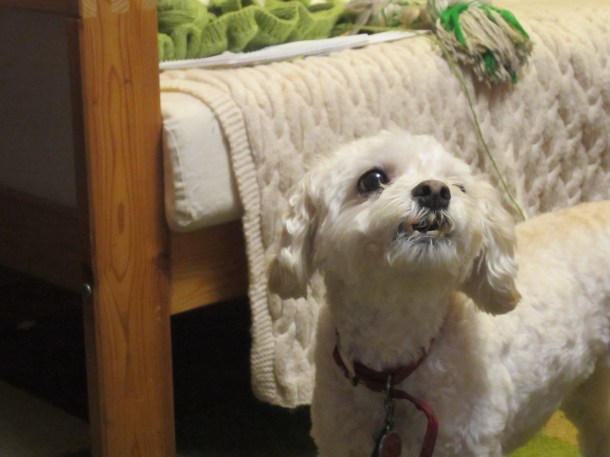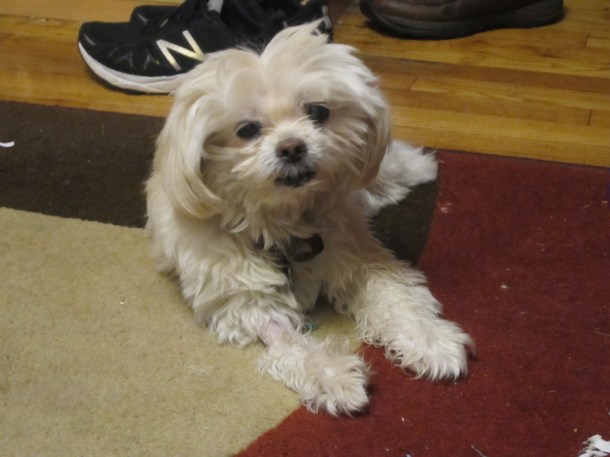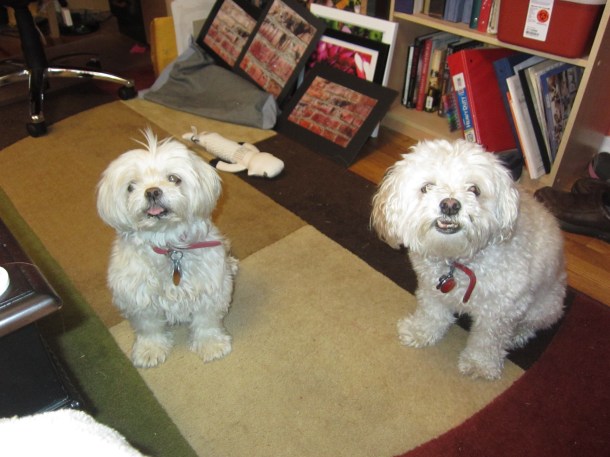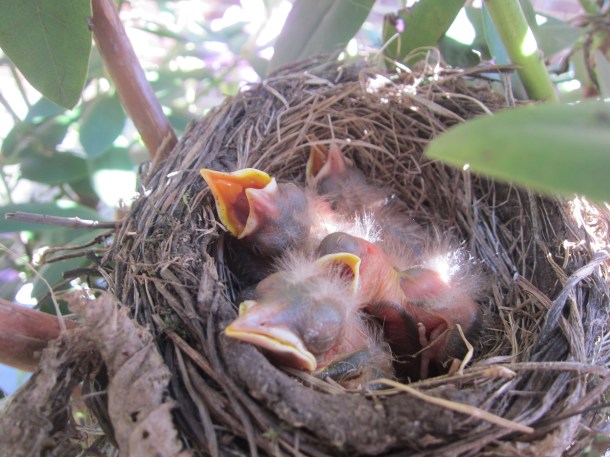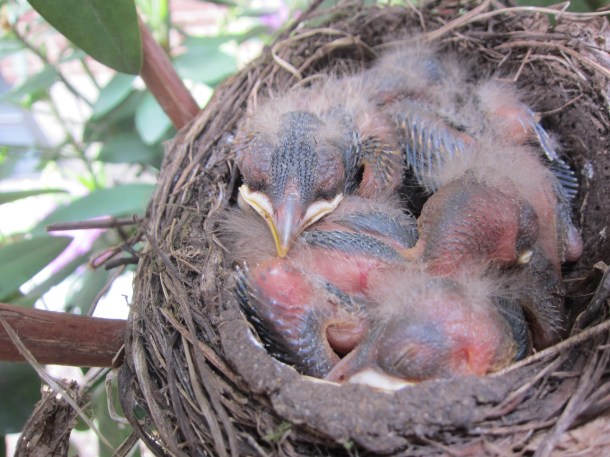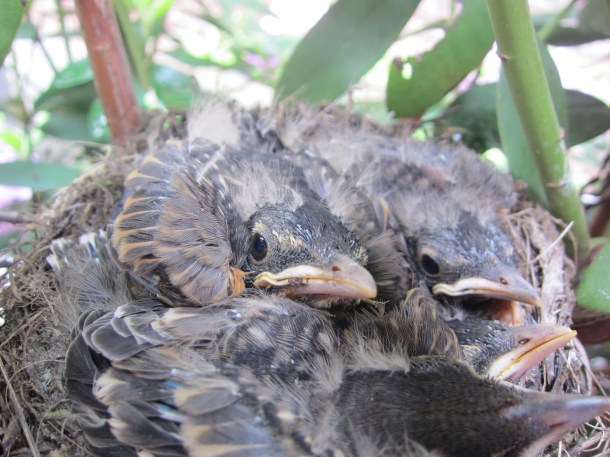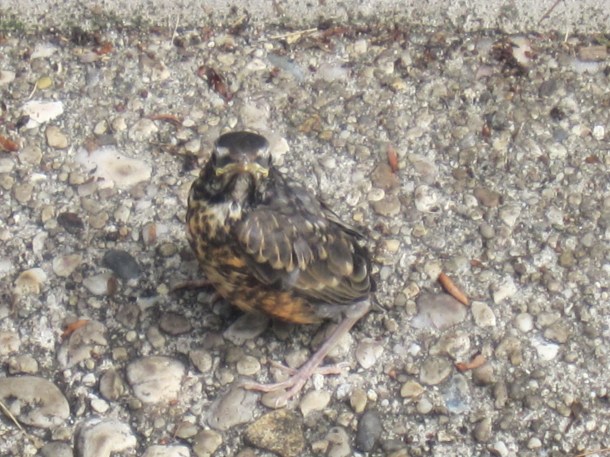Two weeks ago, on Thursday, I came home after five PM and noticed Butterfly standing by the door and panting. When she tried to sit down, she yelped. I checked for the bump on her lower belly that usually causes these symptoms, and it was not only there, it was bigger and harder than usual. These attacks make me nervous because Butterfly’s health is already fragile, with diabetes, and heart trouble, and a persistent cough keeping us perpetually on alert. But most of the time the panting and discomfort, and even the hernia/bump on her lower belly, passes in a few hours. We watched her carefully and gave her extra cuddles, but when we took the dogs out for their late evening walk, Butterfly threw up three times, in purple. I brought her back inside and put her on my bed so I could keep an eye on her, but she couldn’t find a comfortable position. I sat with her and scratched her back as she drooled a river on my bed, and after a while she calmed down enough to decide she wanted to walk down her doggy steps and search for a sip of water and a more interesting place to sleep. I thought that was a good sign.

“I’m fine, Mommy, this is just how I breathe.”
When I woke up in the morning, I expected her to be back to her healthy-ish self, but instead she was listlessly resting her head on her paws, facing the front door of the apartment, next to a drying puddle of pee. Both dogs were scheduled to go to the groomer that morning, and Cricket was blinded by hair and smelled awful, so we dropped Cricket off for her haircut, and took Butterfly directly to the vet for an emergency visit. The people at the front desk were a little snotty with us for not calling ahead, until an hour later when the doctor did an ultrasound on Butterfly’s bump and it became clear that her intestines were compromised and she needed immediate surgery.
We were very lucky that Butterfly’s vet was still there. We had assumed that she would already be gone, and we had said our final goodbyes at Butterfly’s last regular appointment, but it turned out that Butterfly had her emergency just in time, on her doctor’s second to last day at the clinic. In the past, the doctor had discouraged even dental cleanings because Butterfly’s oversized heart would be too vulnerable under anesthesia, but this time she said it was worth the risk. Without surgery, part of Butterfly’s intestines could die and that would kill her just as surely as the anesthesia could.
I held Butterfly in my arms and sang her the Misheberach song, a Jewish prayer for healing, and then I handed her to her doctor. I used up a box full of tissues at the front desk and in the car on the way home, trying not to think that I might never see my baby again.
The doctor called within the hour to tell us that Butterfly was doing well on the anesthesia, but they would need to do a second incision so she would be under longer.
Mom went out to pick up Cricket from the groomer while I did busy work to keep my mind as blank as possible. Cricket returned looking skinny and clean and confused. She was still recovering from her anti-anxiety medication, and the trauma of grooming, but I think the worst part was that her sister wasn’t home to sniff her butt and listen to her plight.

“What is going on?!”
The second call from the doctor came an hour and a half later. Butterfly had survived her surgery and was waking up from the anesthesia, and they wanted advice on what to try and feed her, because her blood sugar was low and she was refusing all of their treats. Even chicken. The relief was extraordinary. The numbness that had taken over my whole body started to recede and instead of crying or something else more reasonable, I started laughing. My baby had survived!
I felt like there was a GPS muttering in my head all that day, “Recalculating, recalculating.” The relief that Butterfly had actually survived the anesthesia was replaced with anxiety when the doctor called again later to say that she wanted Butterfly to spend the night at an emergency veterinary hospital, where a doctor could keep an eye on her, and her breathing. The clinic would only have a technician on duty overnight and the doctor was concerned that if something went wrong, no one would be there to help. She didn’t specify what might go wrong, and she made it clear that the night at the hospital would be very expensive, but she didn’t leave much doubt about the right course of action.
The doctor brought Butterfly out to us, drugged and blurry, and gave us directions to the emergency veterinary hospital twenty minutes away. I held Butterfly in my arms in the front passenger seat of the car while Mom drove, and I listened to Butterfly’s raspy breathing, trying to buffer each bump of the road (she lifted her sleepy head once or twice to let me know that I wasn’t doing a good enough job with that). I could still hear the GPS voice in my head, “recalculating, recalculating.”
As soon as we reached the emergency veterinary hospital, a technician took Butterfly from us, and we had to sit in the waiting room and wait to hear from the doctor on duty. We’d assumed we would just be dropping her off, so the long wait was one more surprise. We finally saw a doctor after eleven PM, and she said that she could hear a crackling sound in Butterfly’s lungs, and wanted to do an x-ray. More waiting. I tried to read the books they had around the room (dog books, of course), but I was worried about Cricket sitting at home alone, needing to pee, barely recovered from her day of anti-anxiety medication and grooming and loneliness.
The x-rays turned out okay, thank God, and then we had to pay the exorbitant estimated bill in order to have the right to visit Butterfly one more time and say goodnight. They led us to a roomful of kennels, set up like high rise apartments, filled with sleepy dogs attached to IVs. As soon as the technician opened the door of her first floor kennel, Butterfly walked out, still attached to her IVs but ready to go home. I tried to explain to her that she needed to stay overnight, but she did not believe me. The technician had to put her back in the kennel for us, because Mom and I were both afraid to risk pulling out one of the tubes she was attached to. And then we finally left, after midnight.
Once again, I had to take deep breaths and tell myself not to think too far ahead. It was a long ride home. Cricket, as predicted, was losing her mind and full of pee. We took her out for a late walk and then we all tried to settle down and get some semblance of a night’s sleep, but even Cricket found the No-Butterfly feeling of the apartment disconcerting.

“I have nothing to say.”
The next day, we paid the rest of the exorbitant emergency vet hospital bill and took a seriously drugged Butterfly (they put her on Methadone!) back to her doctor at the clinic.
Not only did we have to say good bye to Butterfly, again, we had to say goodbye to her doctor, who really was leaving this time.
We had a second night of no Butterfly at home, but at least we knew she was healthy enough to stay at the clinic overnight. The next morning, a new doctor called to tell us that we could pick Butterfly up that afternoon, because she had been taken out for a walk and managed a soft poop. The only trouble was that she still wasn’t eating, and they hoped coming home would reduce her anxiety enough so she would eat.
As soon as the technician brought her out and put her paws on the floor, Butterfly led the way to the exit, even with the Elizabethan collar making the walls hard to spot. We had a bagful of medications to give her and a list of things to do and not do: do not give her kibble; do not give her a bath; do not let her walk up and down the stairs; do give her chicken and rice; pick her up carefully so as not to press on the staples closing her incisions; keep her belly away from magnets (okay, maybe they left that one out, but I really think they should have mentioned it).

“I can walk myself.”

“Where have you been and did you get extra treats that I didn’t get?”

“I do not like this hat, Mommy.”
She still wasn’t ready to eat by the time her nighttime meds were needed, so we crushed the pills in peanut butter, and then spread the mixture, bit by bit, on to her lips. An hour later, her face and my clothes (and the couch and the rug) were covered in peanut butter, but it’s possible that some of the medicine actually got into her system.

Oy.
She started eating chicken and rice the next morning, and took the pills that I broke up and hid clumsily in her food. Then I had to cut off the peanut butter hair left on her chin (whatever she hadn’t managed to rub on the floor herself), and some of the hair around her hygienic areas as well, because she was getting a bit stinky.
Butterfly still had two rows of staples on her belly, and this funny hairless ring on her right front ankle, where they’d put in the IV, and she was a bit slow moving and still on pain medication, but she made the most of my unwillingness to pull on the leash of an invalid. Out on her walks, she started a new habit of walking ten steps in one direction, stopping short, looking around, and then taking ten or fifteen steps in the other direction, just to see if she could get away with it. She could.
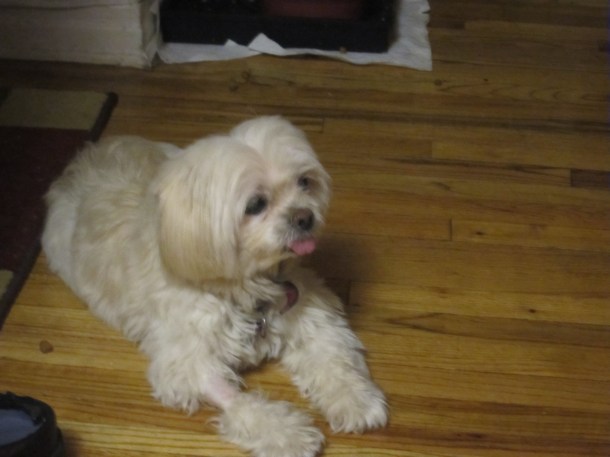
This anklet is the height of fashion. Really.

Ouch.

She’s Home.
Within a few days, she was off her pain meds and back to licking the hand that petted her, and spreading her food in ever widening circles from her bowl (which is much messier with soft rice than it is with hard kibble). She started to walk faster, and then to jog, but she still didn’t think I had any right to control her leash and she made that very clear.
On Wednesday of this past week, not quite two weeks after her surgery, Butterfly went to the doctor and had her staples removed, and celebrated by trying to run all the way home. She’s still not allowed to climb the stairs, and bath time has to be put off for another week, but she thinks she’s all better. She also thinks that now that her belly has been reinforced with extra stitches, she should be allowed to widen her diet to include French fries and pizza, but this is unlikely. I can be stubborn too. She’s a very good teacher.

“Mommy, you learned the wrong thing.”


